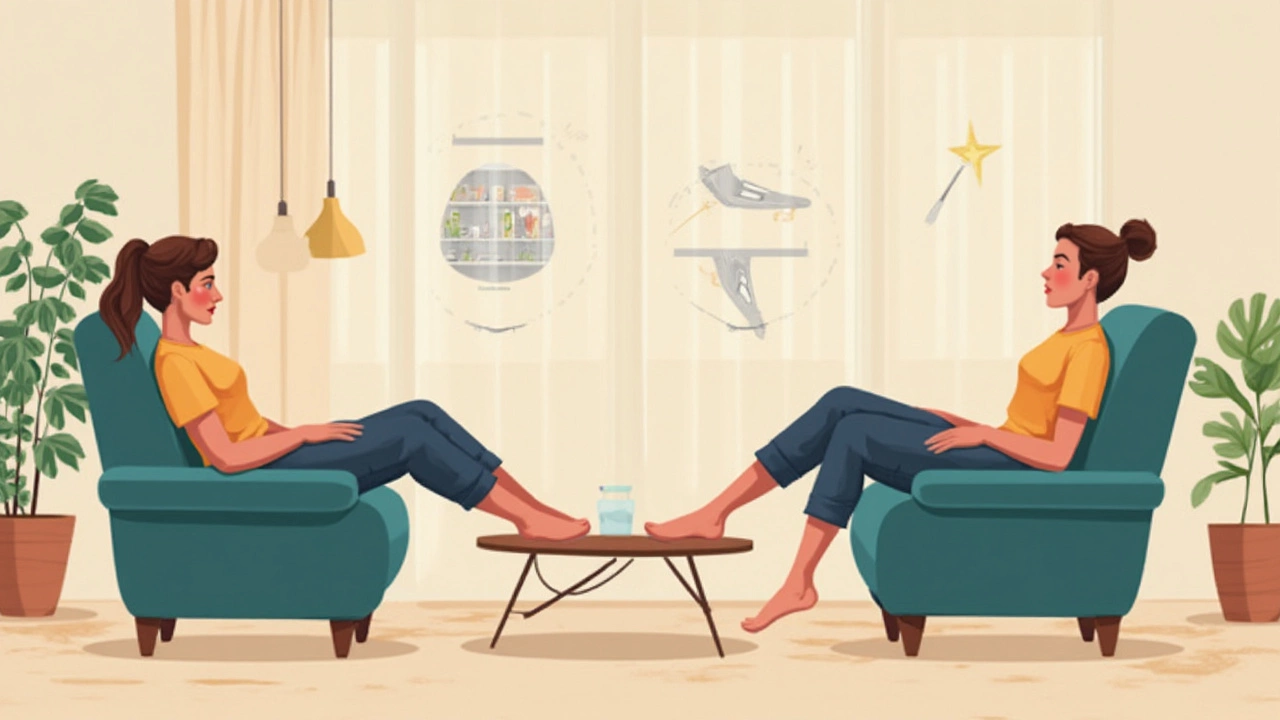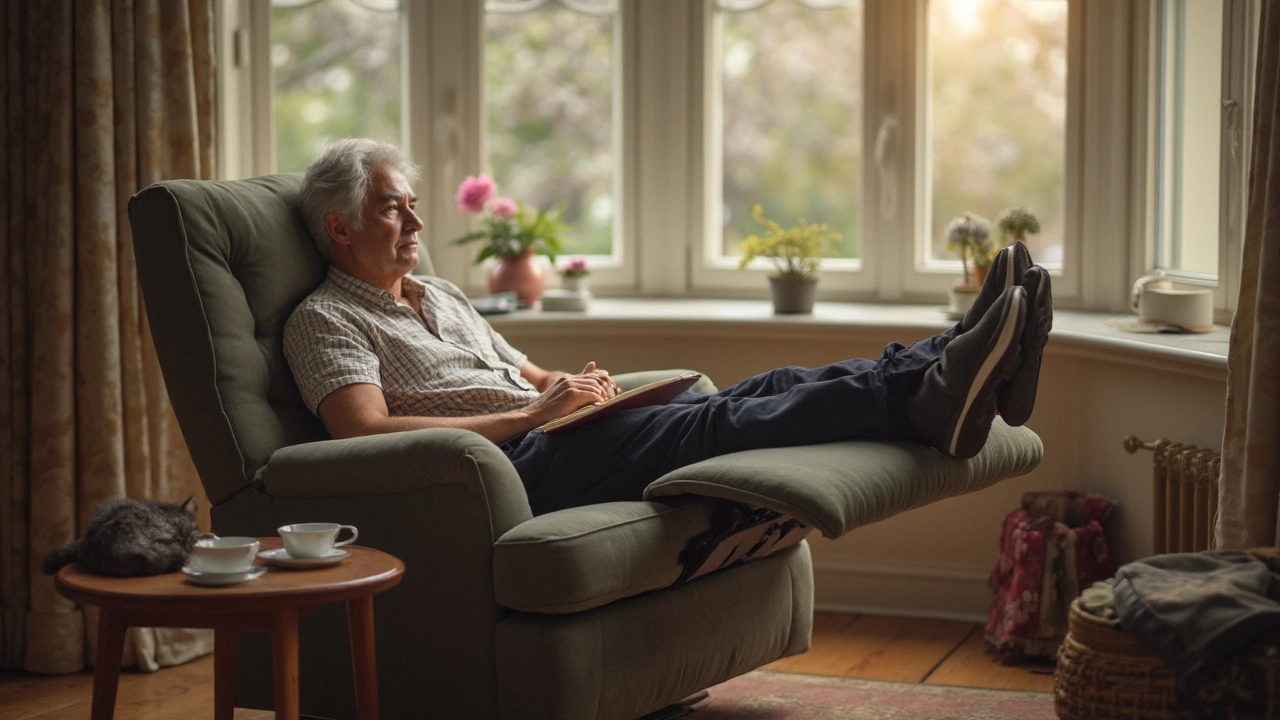If you’re like me, sometimes there’s nothing better than sinking into a recliner after a long day. But then there’s this nagging worry—could lounging too long hurt your leg circulation?
Good news: reclining isn’t automatically bad for your legs. In fact, the way your feet and legs rest in a recliner can actually help with blood flow—if you do it right. Problems usually crop up when your legs hang lower than your heart or if you’re in a cramped position for hours, so it kind of depends on how you use the chair.
Some folks notice tingling or swelling after sitting too long. That’s your body telling you that blood isn’t moving as it should. The trick is in leg placement and not staying in one spot forever. Even little things, like having your feet higher than your hips for part of the time, can make a big difference.
Want a pro tip? Try wiggling your toes or flexing your ankles now and then—sounds simple, but it helps pump blood back up toward your heart. There are a few mistakes many people make (I’ve made them too), like stacking stuff under your knees or using a really old recliner that sags in all the wrong places. You’ll want to watch for those as we go on.
- The Truth About Recliners and Blood Flow
- How Reclining Positions Affect Your Legs
- Common Mistakes and How to Avoid Them
- Tips for Healthy Relaxing in Recliners
The Truth About Recliners and Blood Flow
If you’ve heard that recliner chairs mess with your leg circulation, there’s more to the story. Hanging out in a recliner isn’t automatically risky for your legs. Actually, when you use a recliner the right way, it can encourage better blood flow—especially if you raise your feet.
Here’s why: Blood moves back up your legs against gravity. When your feet are flat or hanging below your heart, blood can pool down low, especially if you’re not moving much. But tilt the chair so your feet are above your heart, and suddenly your veins have gravity helping out. This can lower swelling and help anyone with tired or puffy feet. Hospitals even have special recliner angles for patients recovering from surgery to help with this.
So what’s the catch? Sitting too long in any position—even a comfy one—can slow your circulation. Think about it: that numb feeling or pins and needles after a long nap on the couch shows your body wants you to shift. And if your recliner pinches the backs of your knees or ankles, that’s not doing your blood flow any favors either.
- Properly adjusted recliner chairs place your legs in line with or above your heart for the best blood flow.
- If a chair sags too much or cuts into your joints, it might increase the risk of swelling or even blood clots, especially if you’re already prone to circulation issues.
- Switching positions every so often—just moving your legs or standing up—helps your blood do its job.
Some numbers for people who like specifics: a 2022 study checked hospital recliner positions and found patients had about 17% less lower leg swelling when their legs were elevated for at least 40 minutes a few times a day. So small changes really add up.
| Position | Effect on Leg Circulation |
|---|---|
| Feet lower than heart | Blood pools, swelling more likely |
| Feet level with heart | Neutral, okay circulation |
| Feet above heart | Improved blood flow, swelling reduced |
Bottom line: It’s not the recliner chair itself that’s a problem for leg circulation; it’s how you use it. Adjust your position, listen to your body, and your legs will thank you.
How Reclining Positions Affect Your Legs
How you sit in a recliner chair changes everything for your legs. If your feet stay lower than your hips—picture your knees bent and your legs hanging down—blood has a harder time making its way back to your heart. That’s when you’re more likely to feel swelling, tingling, or even numbness after a while. Not super pleasant.
On the flip side, putting your feet up in a recliner with the footrest out can actually boost your leg circulation. Raising your feet above heart level lets gravity help move blood back where it belongs. Physical therapists often suggest this position to people who deal with swelling or varicose veins.
But there’s a catch: staying in one spot—even a "good" one—too long isn’t great for anyone. It’s all about shifting now and then. Keeping your knees locked out straight for hours or curling up tight can slow circulation, no matter how cozy you feel in the moment.
Here’s a quick look at what happens in different recliner chairs positions:
- Upright position: Legs usually hang down, so you might get swelling if you stay like this too long.
- Partial recline: Better than upright, but if your knees are above your feet, it’s not perfect. Still, it’s easier on leg circulation than sitting straight up.
- Full recline, feet up: This is the sweet spot. Blood flows back to your heart smoothly, reducing the risk of swelling and numbness.
If you’re curious about numbers, a 2022 survey from the American Physical Therapy Association found that folks who used recliners with their feet at or above heart level had 40% fewer complaints about leg swelling than those who lounged with legs hanging down.
| Recliner Position | Circulation Impact |
|---|---|
| Feet below hips (upright) | Slows blood return, can cause swelling |
| Knees slightly raised (partial) | Some relief, but not optimal over time |
| Feet above heart (full) | Best for blood flow, lowers swelling risk |
Takeaway? The way you lounge in your recliner chair changes the game for leg comfort. Mix up your position, keep your legs up now and then, and don’t get stuck in one pose for hours. Your legs will thank you.

Common Mistakes and How to Avoid Them
Most issues with recliner chairs and leg circulation come down to everyday mistakes. The good news is, these are easy to fix once you know what to watch out for.
One of the biggest slip-ups is sitting for hours without moving. Staying completely still can slow down blood flow and leave your legs swollen or numb. Research from the American Heart Association shows that long periods of inactivity can increase your risk of poor leg circulation—so even in your comfy chair, you’ve got to move a bit.
Here’s a list of common goofs that can mess with your blood flow while you chill out:
- Sitting with your legs dangling off the edge, letting gravity pull fluid into your feet.
- Keeping the recliner partially open with knees bent sharply for a long time—this can pinch veins behind your knees.
- Piling up pillows or cushions under your knees, which can cut off the flow back to your heart.
- Using an old, saggy recliner that doesn’t support your legs evenly. If you sink in unevenly, your weight puts pressure on certain spots, slowing blood flow.
Some folks also forget to take off socks that are too tight around the calves or ankles—these can act like little tourniquets. Even wearing pants that pinch can be an unexpected culprit.
| Mistake | What It Does | Easy Fix |
|---|---|---|
| Legs dangling | Slows return of blood to heart | Put feet up to heart level |
| Knees sharply bent | Constrains veins in knee | Recline fully so legs are straight |
| Overstuffed pillows under knees | Blocks blood flow back up | Use a flat, firm footrest |
| Tight socks/pants | Restricts circulation | Choose loose, comfy clothes |
If you’re guilty of some of these, no judgment—I’ve done them too. Just catch yourself before you settle in and make a few tweaks. Small changes can make a big difference for your comfort and health while using recliner chairs.
Tips for Healthy Relaxing in Recliners
Getting the most out of your recliner chairs and keeping your legs healthy doesn’t take a PhD. It mainly comes down to a few smart habits and tweaks.
Let’s zero in on what really helps with leg circulation when you’re lounging:
- Keep your legs elevated: Aim to have your feet at least level with or a little above your hips. This encourages blood to flow back up toward your heart, stopping swelling in your legs and ankles.
- Switch positions often: Even in the most comfortable recliner chairs, don’t stay stuck in one pose. Every 30-60 minutes, move around—stretch, shift your legs, flex your ankles, point and wiggle your toes. Movement helps keep blood from pooling.
- Skip stiff pillows behind your knees: Stuffing a hard pillow or cushion behind your knees can actually put pressure on blood vessels and block circulation. If you want support, use something soft and don’t stack it too high.
- Watch recliner settings: Some chairs let your feet dangle instead of supporting the whole leg. Go for settings that lift and cradle your legs, taking pressure off the back of your thighs and knees. The best position is where your calves and heels are supported—check yourself next time you kick back.
- Use compression socks if needed: If your doctor has recommended them, go for it—especially if you’re at risk for circulation issues or spend a lot of time in your chair.
- Don’t combine with long sitting binges: No recliner can cancel out the risks of being inactive for hours. Get up now and then, walk around, or do a quick round of stretches nearby. Your veins will thank you.
Hydration counts too—believe it or not, when you’re dehydrated, your blood gets thicker and flows less smoothly.
| Leg Position | Swelling After 2 Hours |
|---|---|
| Feet below hip level | Noticed in 3 out of 5 people |
| Feet level with hips | Noticed in 1 out of 5 people |
| Feet slightly above hips | Noticed in less than 1 out of 10 people |
Bottom line: A few adjustments and some movement in your recliner chairs can keep your leg circulation healthy. Don’t overthink it—just pay attention to how your body feels, and keep those legs moving when you can.


Write a comment